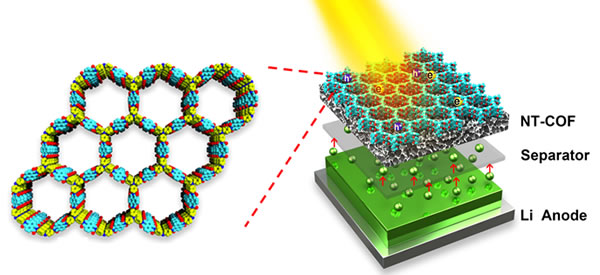Storing solar energy in an electrochemical energy storage device is an effective method to solve the intermittent supply of solar energy and realize its wide application. The traditional method is to connect the solar cell to the energy storage device through long wires. The introduction of long wires will cause ohmic loss, thereby reducing the conversion and storage efficiency of solar energy. The design and preparation of high-efficiency (photo) electrical functional electrode materials is the key to the development and construction of simple two-electrode system devices to obtain high-efficiency and low-cost photo-assisted electrochemical energy storage devices. With the support of the National Natural Science Foundation of China, the Strategic Leading Science and Technology Project of the Chinese Academy of Sciences, the Key Laboratory of Nano and Assembly of the Chinese Academy of Sciences, etc. A dual function material that absorbs and reversible electrochemical energy storage directly converts solar energy into electrochemical energy. First, Tan Yanxi, an associate researcher in the research group of Yuan Daqiang, synthesized a covalent organic framework material (NT-COF) with naphthalene diimide (NDI) and triphenylamine (TPA) units. NT-COF appears to be filled with two-dimensional porous nanosheets with a high specific surface area of ​​1276 m2 / g. Dr. Jiangquan Lu from the Wang Yaobing research group conducted a detailed photochemical / electrochemical characterization, which revealed the efficient intramolecular charge transfer from TPA to NDI units within NT-COF and the highly reversible electrochemical reaction of the material. Taking NT-COF as the cathode material of lithium-ion batteries, the charging voltage is reduced by 0.5 V and the discharge voltage is increased by 0.5 V under light. The efficiency of the entire battery is increased by 38.7%, and the effective use of solar energy is realized. This work is based on a dual-function cathode material that has a synergistic effect of reversible electrochemical reaction and intramolecular charge transfer. New ideas. The first author of this article is Lu Jiangquan, and the co-first author is Tan Yanxi. The research results were published in "German Applied Chemistry" (Angewandte Chemie International Edition, DOI: 10.1002 / anie.201806596). 3mm Cylindrical LED, 3mm white LED, white LED Lamps, 3mm warm white LED, 3mm cool white LED Shenzhen Best LED Opto-electronic Co.,Ltd / BESTSMD CO LIMITED(HK) , https://www.bestsmd.com
Figure: Schematic diagram of covalent organic frame material structure; right: Schematic diagram of light-assisted lithium-ion battery
We supply kinds of 3mm Through-hole LED with different wavelength from 365nm to 1550nm, which include the visible LED and the invisible LED.
In this catalog, we mainly introduce the 3mm White Through-hole LED.
3mm Through-hole LED, we supply 3mm white LED with water clear lens and 3mm white LED with white diffused lens. We also supply 4mm white LED with white clear lens and 4mm white LED with white diffused lens.
3mm white Through-hole LED widely used for indicator LED, die hole LED and 3mm round white with lamp holder because of the high brightness and the small size.
For the pin of 3mm white through-hole LED, we also have a lots of choice on it. For example: 3mm white Through-hole LED flat pin, 3mm white Through-hole LED curved pin, 3mm white Through-hole LED braided pin ect.
For the bringhtness of 3mm white through-hole LED, we have three level: common bright 3mm white through-hole LED, super bright 3mm white through-hole LED and ultra bright 3mm white through-hole LED.
For the angle of 3mm white through-hole LED, 15 degrees, 30 degrees, 45 degrees, 60 degrees, 120 degrees are available.
For the raw materials, we use the LED chip from Taiwan Epistar, Tyntek, Optotech. The stability of our products have been recognized by all of our custom.